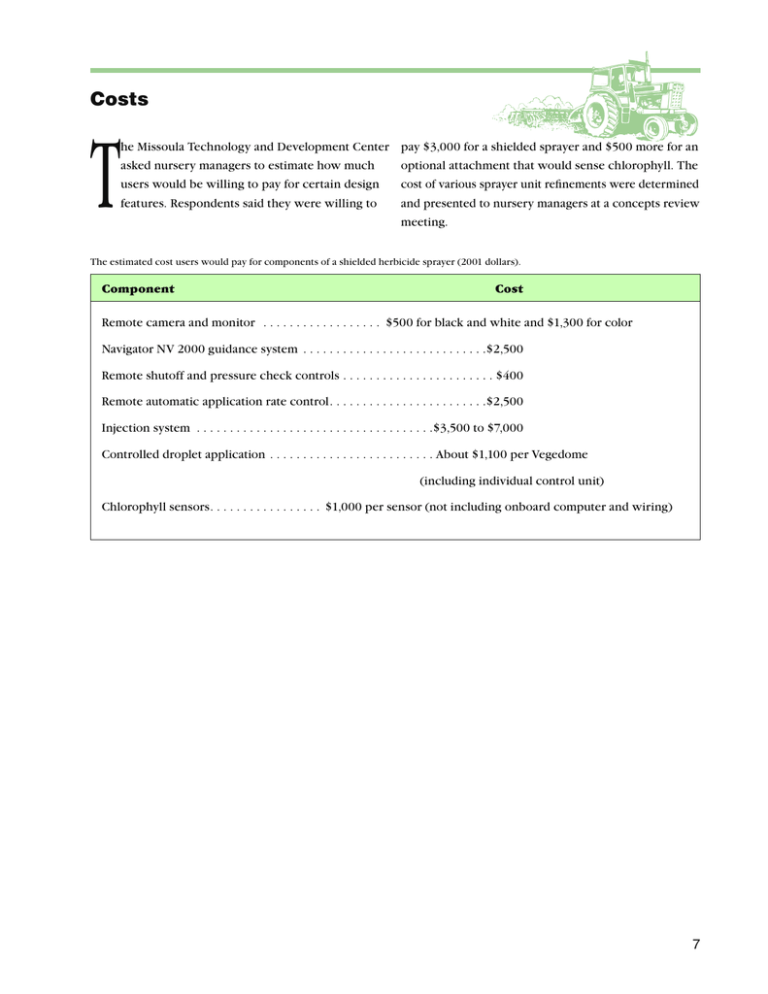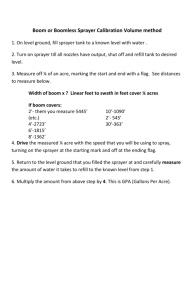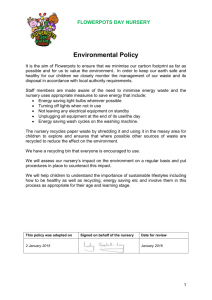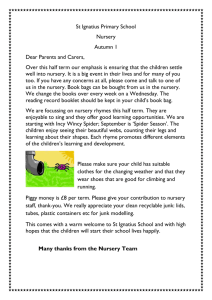T Costs
advertisement

Costs T he Missoula Technology and Development Center asked nursery managers to estimate how much users would be willing to pay for certain design features. Respondents said they were willing to pay $3,000 for a shielded sprayer and $500 more for an optional attachment that would sense chlorophyll. The cost of various sprayer unit refinements were determined and presented to nursery managers at a concepts review meeting. The estimated cost users would pay for components of a shielded herbicide sprayer (2001 dollars). Component Cost Remote camera and monitor . . . . . . . . . . . . . . . . . . $500 for black and white and $1,300 for color Navigator NV 2000 guidance system . . . . . . . . . . . . . . . . . . . . . . . . . . . .$2,500 Remote shutoff and pressure check controls . . . . . . . . . . . . . . . . . . . . . . . $400 Remote automatic application rate control . . . . . . . . . . . . . . . . . . . . . . . .$2,500 Injection system . . . . . . . . . . . . . . . . . . . . . . . . . . . . . . . . . . . .$3,500 to $7,000 Controlled droplet application . . . . . . . . . . . . . . . . . . . . . . . . . About $1,100 per Vegedome (including individual control unit) Chlorophyll sensors . . . . . . . . . . . . . . . . . $1,000 per sensor (not including onboard computer and wiring) 7 Concepts Review Meeting M TDC presented alternative design philosophies and identified commercially available products at the annual meeting of the Southern Forest Nursery Management Cooperative in 2001. The group was interested in a simple, low-cost design without bells and whistles. They were not especially concerned with conservation of herbicide or reducing the number of personnel required to perform the operation. They said they would only be applying glyphosate, which requires minimal personal protection for the applicator, based on the chemical’s label. They wanted the applicator to focus was to be avoided at all cost. The Egedal sprayer met all of the operational requirements, but was too expensive. Mechanical weeding without herbicides was not desired by the group. They thought a sprayed herbicide was necessary to eliminate the hardier nursery weeds. The FOBRO Brush Hoe was said to work well enough on small weeds in cultivated ground. Some of the more aggressive and efficient mechanical weeders required a special tractor. The roller/wick applicators were ruled out because they might become coated with mud when on applying herbicide to the plants rather than having working on shorter weeds. The other refinements were to drive the tractor. Herbicide escaping from the shields thought to cost too much. 8 Nursery Prototypes I n the early stages of this project, a search was conducted for shielded hardwood nursery sprayer prototypes. The six that were identified were from: Southern Weed Science Lab (figure 12); Winona Nursery (figure 13); Pinson Nursery (figure 14); W.W. Ashe Nursery (figure 15); the Texas Forest Service (figure 16); and E.A. Hauss Nursery (figure 17). Shop-quality mechanical drawings of the prototypes from the Southern Weed Science Lab, and the Winona and Pinson Nurseries are available on the MTDC Nurseries Drawings Web site: http://www.fs.fed.us/t-d/dwf/nurseries (Username: td, Password: t-d). Figure 12—The drawing for a sprayer designed by the Southern Weed Science Lab in Stoneville, MS. The hoods are made of sectioned PVC pipe. The tractor driver operates the sprayer. Figure 13—A prototype sprayer developed by the Winona Nursery (Winona, MS). The sprayer assembly is raised and lowered by a hydraulic cylinder actuated by the operator. The spray tank is mounted in front of the tractor. 9 Nursery Prototypes Figure 14—A prototype sprayer developed by the Pinson Nursery (Pinson, TN). The entire sprayer tilts up and back when the tractor is not being used for spray operations.—Courtesy of Tom Strickland/Mike Sheryl Figure 16—A Texas Forest Service prototype sprayer.—Courtesy of Harry Vanderveer Figure 15—A prototype sprayer developed by the W.W. Ashe Nursery (Brooklyn, MS).—Courtesy of Chuck Grambling Figure 17—A prototype sprayer developed by the E.A. Hauss Nursery (Atmore, AL). The tractor driver operates the sprayer. The nursery seems very pleased with this machine.—Courtesy of Craig Frazier 10






